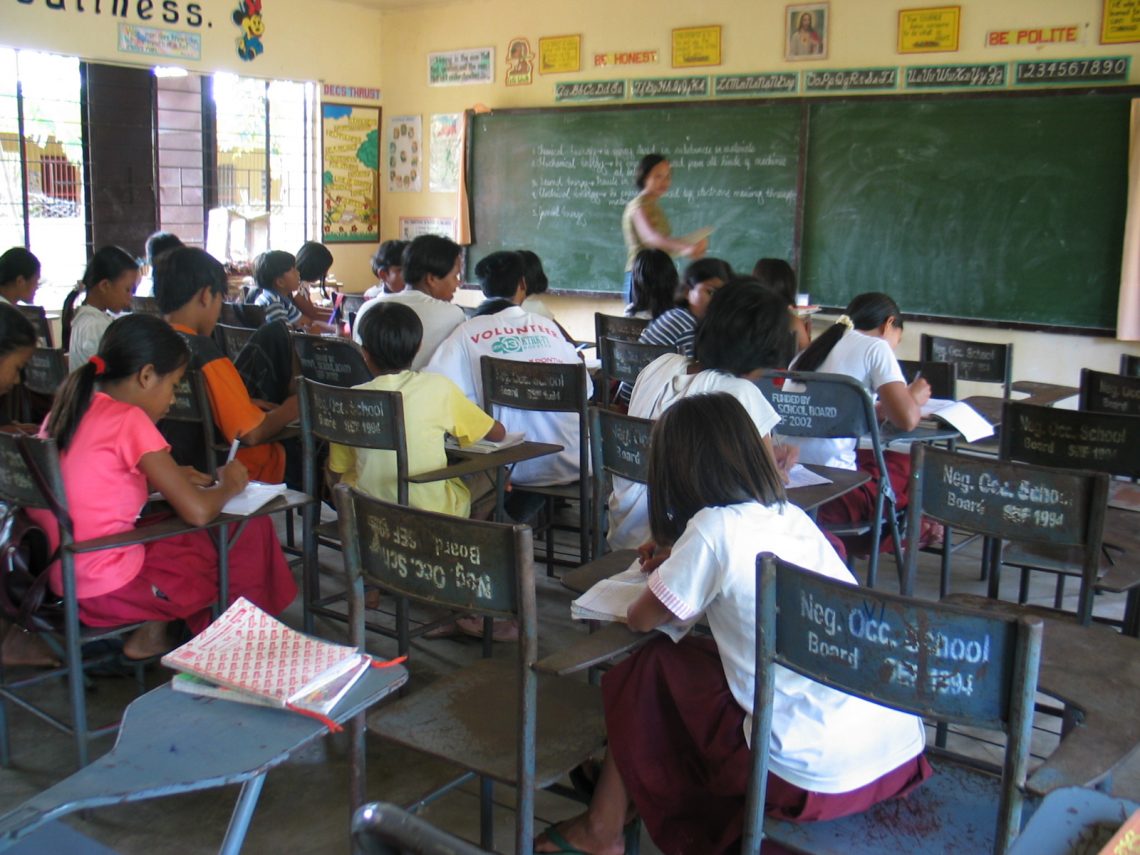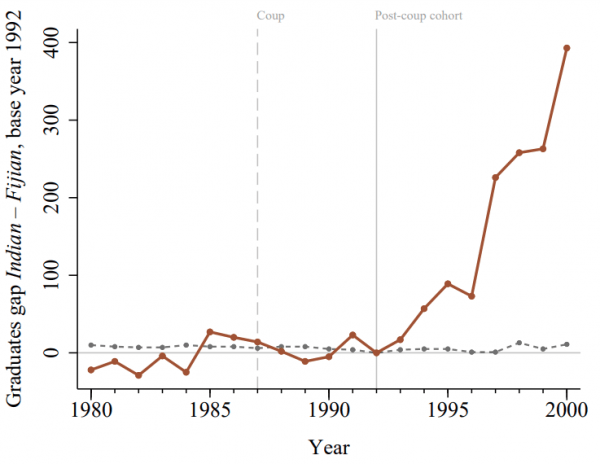This second post in the series summarises four recent studies on brain drain after a brief methodological digression. The last post stressed the importance of getting the time horizon right when evaluating a possible brain drain, allowing any dynamic responses to play out.
Another challenge is attribution. It is not enough to compare skill levels before and after migration, as skill levels are affected by more than just migration. Similarly, naïve comparisons between migrant sending and non-sending areas are also inappropriate, since migrants and the areas they come from tend to be different. To answer causal questions, we need counterfactuals: credible estimates of the state of the world without migration.
Experiments – like randomised controlled trials used to test the efficacy of new drugs – often provide the most credible and certainly the easiest to explain counterfactuals in social science, with “control” groups differing from “treated” groups only in whether they were randomly assigned the treatment. Visas sometimes cannot be randomised (although this is clearly the fairest way when there are more people who want to move than there are places) so good empirical researchers instead seek to approximate experiments though a careful understanding and modelling of selection into the program.
Migration lotteries (for example, the US Diversity Visa and New Zealand’s Pacific Access Category and Samoan Quota) offer real-world experiments helpful for understanding the scale of the challenge at hand. The 2010 study comparing lottery-based and observational estimates of the impacts of migration to New Zealand from Tonga finds that most non-experimental estimates are off by between 20-83 per cent. This level of bias in an estimated effect size is alarming, and may be enough to reverse the sign of the effect and substantive conclusions. In describing what we have learned since Clemens and McKenzie, I’ll be consistent with them and ensure that evidence meets the same standards (that is, rigorous quantitative causal studies which carefully understand selection, convincingly discern cause from coincidence, and measure impacts).
Cape Verde is a ten-island archipelagic country off the West African coast, with a population of just over half a million and limited natural resources. With around 70 per cent of its highly educated population residing abroad, it was long alleged to have the highest brain drain in Africa. In a 2010 paper published in the Journal of Development Economics, Catia Batista, Aitor Lacuesta, and Pedro Vicente use a special household survey to estimate the effect of changes in future migration prospects on household educational attainment. The authors use the entire migration history of all household members to carefully model the decision to migrate and recover causal estimates. Although out-migration leads to a direct immediate loss in human capital, by increasing the expected returns to education (for example, through the place premium) it could also encourage more education. This is indeed what the authors observe: a ten percentage point increase in the probability of own future migration corresponds to a four percentage point increase in secondary schooling completion. Counterfactual simulations point to positive net effects – that is, a brain “gain” rather than “drain” and significant human capital gains from lowering migration barriers.
A more recent paper by Slesh Shrestha published in the Economic Journal uses the introduction of selection criteria to recruit Nepalese men for the British Army to study how migration prospects affect human capital accumulation for the entire eligible population. The British Army unit composed of Nepalis was traditionally recruited from the Gurkha ethnic group (five Mongol-Tibeto tribes) and this ethnicity bias persists (all British Gurkha soldiers in the 2008 Nepal Labour Force Survey belong to this group). Since the policy changes in 1993 and 1998 required recruits to have at least eight and ten years of schooling, the author compares changes in male education between eligible (that is, those making education decisions after the policy change) and ineligible (before) cohorts within Gurkha (treated) and non-Gurkha (control) to isolate the effect of the policy change. The increase in relatively skilled emigration prospects for Gurkha men led them to invest more in education than other ethnicities. There was a net improvement in education levels (1.2 extra years, on average for everyone) and employment outcomes for the Gurkha men that remained behind (relative to the non-Gurkha comparison group). Given Nepal’s importance in the global migration landscape and the fact that not all evidence is created equal, this is crucial evidence of how migration prospect mechanisms can reverse potential brain drains.
The most important case for circular (that is, repeat) migration, as is increasingly common in the various Pacific schemes, is arguably the Philippines. In a study published last year in the Journal of Human Resources, Caroline Theoharides studies how international out-migration affects education back in the Philippines for entire migrant-sending communities (that is, local labour markets). She compiles an impressive dataset of all migrant departures and develops a careful research design exploiting changes in demand within migrant receiving countries. The results are striking but by now should not be particularly surprising: the average year-on-year increase in migration causes a 3.5 per cent increase in secondary school enrolment. An interesting aspect of this study relative to the others is that, by exploiting gender-specific migration demand, the author shows that a generalised increase in local sending-area income – rather than an increase in the expected wage premium and the prospect effect – is the key channel at work.
The studies described above focus mostly on school-level educational attainment. But how do post-secondary skills respond? The final study I want to discuss is by Michael Clemens and Satish Chand, a Professor at UNSW and himself a Fijian migrant to Australia. Clemens and Chand’s study is a “natural” experiment around the series of affirmative action policy changes favouring ethnic Fijians following the 1987 coups, which Indians perceived to permanently disadvantage them. The study also represents a tremendous data collection effort including annual reports from the Fijian Ministry of Education, university graduates and subsidies, Fijian departures and arrivals, Australian settler visas by type issued to Fijian-born people, and the complete Fijian census microdata. Like Theoharides and the Filipino records, this study highlights the immense public benefits that can arise, at little to no cost, when governments let researchers take advantage of their excellent data to generate evidence for them and the public.
Event study coefficients: graduates’ majors at the University of the South Pacific in Fiji
Source: Clemens and Chand, 2019
Clemens and Chand find that the sharp increase in discrimination caused one of the largest, fastest emigration waves on record, mostly by skilled Indians. It led to an increase in skill investment so large that skilled stocks rose net of skilled emigration. One important contribution of this study is that, since Australia’s skilled emigration is governed by a points system, the authors use Fijian university data to show how graduations strongly shifted towards degrees that facilitated migration (such as, computing science and IT, accounting and financial management, and school teaching, which received the maximum skill points). Rather than just the general increase in education levels associated with repatriated incomes, this study provides rigorous, contextually-relevant evidence of behaviour consistent with migration prospect effects for post-secondary skills in the Pacific.
Although “brain drains” are theoretically possible, particularly for smaller countries and particular professions (for example, this note on doctors), recent evidence suggests that over the long term this continues to be the exception (see, for example, this important study on Mexico) rather than the rule. Yet, this is not to say that governments don’t need to worry about brain drain and that there are not challenges. Labour market imperfections mean it may take some time for under- and unemployed workers to replace previously employed migrants, and firms wear these turnover costs. Rationed education places may limit a supply response. Government-set salaries could limit wage responses. Increased demand for education or higher salaries could place additional pressure on already tight government budgets. As with other key aspects of globalisation (for example, exposure to trade and migration more generally), it is important to not throw the baby out with the bathwater. Good policy can often help smooth the short-term adjustment costs and build the political constituency to sustain longer-term gains. In the next post, I’ll reflect on brain drain concerns and human capital issues going forward with the Seasonal Worker Programme, the Pacific Labour Scheme, and Pacific labour mobility more broadly.
This blog is the second in a three-part series.






